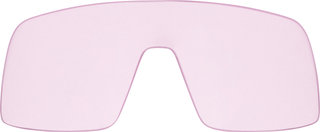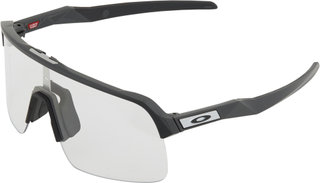Eyewear
OUR Eyewear RECOMMANDATIONS
Our Suggestions
Keeping with the motto "see and be seen", many models offer a casual look in addition to function. To help you find the right frames in our extensive selection of cycling eyewear, we’ll briefly go over a few aspects to keep in mind when you’re riding your bike. View Guide
Full View and Good Protection
Unlike normal sunglasses or simple safety goggles, eyewear for biking is specially optimised to suit the needs of cyclists. When choosing your glasses, you should consider a few important product features in addition to the area of use and the tint of the lens. There are various types of eyewear for cycling – from rimless, very light glasses to shield glasses and goggles. Fit, aerodynamics, ventilation, the mechanical protection effect and also the weight depend on this. Our eyewear range includes designs from premium brands such as Oakley, Uvex, 100, POC, Alpina, Fox Head, Leatt and others, with countless combinations of features to suit all tastes and needs.
What Type of Eyewear Goes with Which Bike?
Application is an important criterion for choosing the best glasses. Road cycling glasses afford very good wind protection as you maintain a high speed on the road. The ideal eyewear for mountain biking should be able to withstand vibrations and protect your eyes from flying dirt. As speed varies greatly when you’re riding off-road, good ventilation and anti-fog coatings play an important role in keeping your vision clear. Tint is mostly optimised for changing light conditions. Lens colours that enhance contrasts in the forest also afford great advantages for mountain bikers. For downhill riding, goggles are usually preferred to glasses, as they offer maximum protection and ensure a secure fit on the toughest terrain. Of course, there are also universal cycling glasses that you can use on a mountain or gravel bike, road bike, e-bike or even in everyday urban settings and on a touring bike. With interchangeable lenses, you can also adapt some models depending on what type of bike you’re riding.
Cycling Eyewear: What About Lens Colour?
Lens colour affects how well you can perceive contrasts and colours through glasses. MTB goggles, for example, should enhance contrasts in natural environments. High-end brand Oakley offers cycling glasses with PRIZM lenses, which go beyond a simple tint to filter certain areas of visible light, which helps you to view your surroundings with particular clarity. For cycling glasses with interchangeable lenses, you can change the lens colour as needed. It is best to check the product description to see whether interchangeable lenses are included with the eyewear of your choice or whether they are available separately.
Cycling Eyewear: What About Tint?
The lens tint on a pair of cycling glasses indicates the degree of darkening. In particularly bright environments, dark cycling sunglasses with a strong tint are recommended to reduce your exposure to glare. Cycling glasses with self-tinting (photochromic) lenses are particularly convenient, as they automatically adjust to ambient light conditions. For example, if you’re riding from an open field into a shady part of the forest, the lenses will adjust to a lighter tint on their own. By the way, you don't need particularly dark lenses to protect your eyes from UV radiation – high-quality clear lenses can also do this while also providing you with unfiltered vision.
The Shape and Size of Cycling Eyewear
Whether you purchase a rather small and discreet pair of cycling glasses or a large, eye-catching pair is not just a question of aesthetics and taste. The design also has a big influence on the glasses’ or goggles’ protective effect. The larger the lenses, the more protection they offer against wind, rain, insects and dirt, and the broader your field of vision is. A continuous lens over both eyes not only offers uninterrupted vision, but also aerodynamic advantages. You can choose between a full rim, half rim and rimless glasses. Unlike normal glasses, the lenses on most types of cycling eyewear are strongly curved. This provides a closer and more streamlined fit to the face and offers protection on all sides. One advantage of small glasses is their light weight, and that they’re easier to stash in your jersey pocket or backpack if you don't want to wear them all the time. In general, you should also consider your helmet when choosing the size and fit of your new cycling eyewear. Make sure your frames fit your head’s shape and don’t touch your helmet.
Maximum Protection with MTB Goggles
As with winter sports, goggles offer maximum wind protection on a bike. Unlike glasses with temples, they are held in place with an elastic strap that runs across the back of the helmet. The goggle frame is padded with foam and rests across your face evenly. Goggles are mainly suited for fast descents and are therefore standard equipment for downhill riding. Although ventilation plays a secondary role here, MTB goggles are better ventilated than those used in skiing or other winter sports. Many open-face helmets have a visor that you can push up so far that you can “park” goggles underneath. This way, you can enjoy maximum protection downhill and simply slide your goggles up during ascents. Positive side effect: goggles can additionally improve the secure, wobble-free fit of a helmet.
Cycling Eyewear for Glasses Wearers
Cyclists who are visually impaired can also use cycling eyewear. Some models in our range are suitable for being fitted with prescription lenses by your local optician. A flexible alternative is contact lenses, with which you have the whole range of cycling eyewear at your disposal. If you are mainly looking for wind protection for MTB downhill riding, then you can try goggles. Small corrective glasses can be worn underneath them, and there are also models that are designed to be a little roomier just for glasses wearers; they’re also known as OTG (over the glasses) goggles.




































